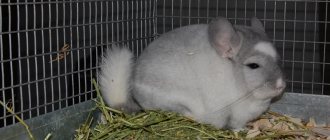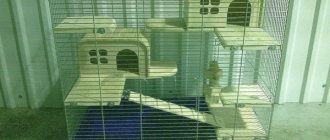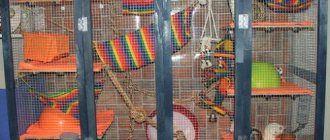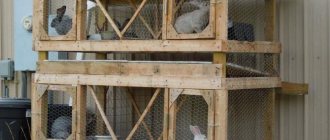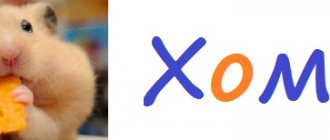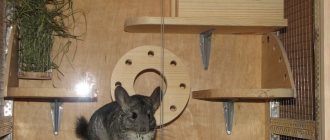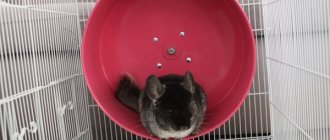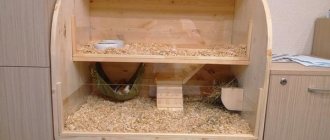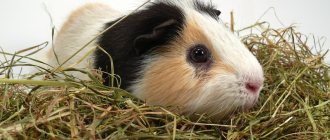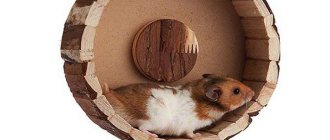So, the decision to purchase a Chilean squirrel has already been made. But before you bring a new pet into your home, you need to prepare a home for it. After all, unlike a kitten or puppy, a rodent cannot be “settled” in a chair or on a doormat.
You can purchase a degu cage at a pet store or make one yourself. And expert advice can help you set up a house for a restless animal.
What kind of cell should a degu have?
Before you start creating a cage for a degu, you need to study the lifestyle of this rodent in order to provide it with comfortable conditions. The Chilean squirrel is called the bush squirrel due to the fact that it does not run through trees and forages for food in low thickets.
This fact should be taken into account when designing the cage - degus are not adapted to climb trees, but a route up and down must be provided for them.
In the wild, this unusual animal lives in burrows underground. In them, the squirrel arranges a bed and escapes from foxes and birds of prey. At home, there will be no such danger to life, but the habit of hiding in holes will remain. Therefore, you will have to place a piece of pipe in the degu’s cage to simulate an underground shelter.
It is recommended to purchase a couple of rodents at once, since Chilean squirrels in the wild live in large groups. Therefore, the size of the degu cage must be large enough to accommodate several animals.
Squirrel owners often share observations of how their pets chew holes in insufficiently strong wire mesh, not to mention exposed wooden structural elements. Therefore, all parts of the degu house must be designed to withstand heavy loads. In addition, the structure must be made of high-quality and safe materials.
Experts recommend focusing on the universal size of the structure for squirrels: 1 m (width) x 60 cm (depth) x 1.2 m (height). But these dimensions are considered minimal, and if possible, it is necessary to organize a larger space for the degu.
This is interesting! In nature, the Chilean squirrel is diurnal. The degu comes out for food early in the morning and spends the whole day searching for food, returning to its hole for a short time.
The nuances of feeding a newborn
Squirrels have a longer gestation period than other similar animals, such as rats or hamsters. Therefore, babies develop a little faster. Newborn squirrels look just like their mothers. They already have fur and their eyes are open. In addition, there are teeth almost immediately.
However, at first they move very poorly and only after a week will they be able to try to get out of the nest. The squirrel does an excellent job of feeding its babies. However, you should not pick them up, as she may refuse to feed. Therefore, if you need to take your baby, for example, for an examination, be sure to wash your hands with soap so that the squirrel does not smell the person.
In addition, it may also happen that the squirrel dies during childbirth or shortly after it - then a person must take care of feeding. This can be done using milk mixture heated to +36 degrees. Feeding can be done using regular pipettes or a syringe without a needle. If they are not there, then an ordinary cloth soaked in the milk mixture will come in handy. The mixture can be prepared from cow's milk and chamomile tea. The proportions should be 1 to 2.
The baby squirrels need to be fed every 2-3 hours. After each feeding, be sure to massage their belly. You need to feed the mixture for no more than 30 days, then you can gradually introduce dry food into the diet, for example, hay or grain. In addition, you can also give some nuts, vegetables and fruits.
A 2-month-old baby can eat almost everything. Therefore, they can be transferred from a nest to a cage, to a permanent place of residence. From now on, they begin to live an adult life and, accordingly, eat like that. Some owners give them formula milk for some time, only from a small saucer.
Making a wire enclosure for degu with your own hands
Making a degu cage with your own hands is not a difficult task, but it requires some experience. Many manufacturers prefer wire frames precisely because of their primitiveness and simplicity. But making such a house yourself can be problematic.
The fact is that factory-made products are most often formed according to the frameless principle, but for an individual home project you will have to prepare a wooden base.
The lower closed part of the squirrel cage is made of bars. It should provide two functions:
- provide a reliable foundation for the entire superstructure, which will be fixed on top;
- make it possible to remove the bottom tray to replace the bedding on which the degu sleeps.
The height of the “zero” floor is 10-15 cm.
Material – timber (section 30-50 mm).
The sheathing for the cage is plywood.
All internal sides of the cage must be “sewn up” with metal or at least plexiglass. Smooth surfaces are resistant to the teeth of a rodent; he will not be able to make a hole in them. But plastic is strictly unacceptable here.
The bottom tray can be found ready-made, but there is a problem with the exact dimensions. It is desirable that it tightly covers the bottom and does not leave any gaps. The point is not only that the degu can use its teeth to widen these gaps - in such places the squirrel can easily injure its paw. The best option would be a metal tray, which can be easily removed through a special opening in the front wall.
Another option for making the lower part of a degu cage with your own hands is simpler. There is no need to make extra slots for the tray in the design, and it is cleaned and the bedding is changed through the rear door.
After the problem of the first floor has been solved, frames for the front, rear and two side walls are made from a block with a cross-section of 3-5 cm. A metal mesh is attached to them (except for the back part) and connected to the lower element. All that remains is to make the door in the rear vertical plane. It can be made of plywood or in a combined version - of wood and mesh.
Important! It is strictly unacceptable to use any glued chipboards as materials for the cage. Adhesion in them is achieved due to various chemical compositions - if the squirrel’s teeth get to such elements, then it will probably be poisoned.
Content Features
Keeping any exotic animal has its own subtleties and nuances. Below are some useful tips and tricks for keeping degus:
- Before getting a squirrel, ask your veterinarian for detailed information about vaccinations and possible diseases;
- carry out deworming with special preparations once a quarter;
- if a rodent’s hair begins to fall out, its eyes become lighter, and lethargy appears, then this is a sure sign of an illness that requires emergency care;
- There must be hard twigs or sharpening stones in the cage. If they are absent, this will lead to discomfort and deformation of the jaw;
- When letting your squirrel go for a walk, you should monitor its movements. It is best to buy a special walking ball at a pet store, then the rodent will not be able to harm your furniture and electrical wires;
- Degus are amazing rodents. They sleep all night and begin active life only in the morning and daytime hours. This rodent is ideal for owners of small apartments;
- The lifespan of bush rodents is 8 years in captivity. And after reaching five years, they stop reproducing.
If you dare to get a bush squirrel, you will not regret it. They are unpretentious, smart, and most importantly, they do not have an unpleasant odor. Degus will make wonderful friends for families with children. They get along well with all residents of the house and pets.
Authors of the articles: Belanta Clinic team
Making a display cage for degu
A display cage differs from a wire cage in the materials used to make the front and side walls. They can be made of glass or plexiglass. In general, this design is very similar to a large aquarium, which is visible from all sides.
This cage for a degu squirrel has the following advantages:
- the pet will not get hurt on the metal mesh, which he will definitely chew;
- the rigidity of the vertical surfaces and additional stability of the entire structure are ensured - the wire mesh has to be pulled tightly so that it does not sag.
You can use an old linen or bookcase to create a display case:
- The mezzanine is moved to the lower tier. It is very convenient to store all kinds of tools for cleaning the cage, food, toys and other attributes of a squirrel’s life. Otherwise, you can make such a box yourself.
- The wood is completely cut out from the side walls so that only a solid frame remains. Transparent plexiglass is inserted into it.
- Mark the floors (25-35 cm) and cut ventilation holes in the side walls at each level. In the future, they should be covered with a net so that the degu does not escape through the holes in the cage.
- The back side should transform into a door, and the front plane should be left completely transparent.
- Next you need to work on the roof of the cage. In it, a part of a wooden structure is cut out from the middle, and the hole is covered with glass or plexiglass. Now you can organize outdoor lighting - there will be light in the display cage, but the lamp and electrical wires will be outside the Chilean squirrel’s habitat.
Important! You should not install a degu cage in areas with bright sunlight or at the level of doors and windows - drafts will not benefit the health of a small rodent.
Why her?
There are many other small animals!
- Because Chilean squirrels are unique. Few exotic animals are capable of learning and training. Degu - can follow simple commands and makes contact easily, unlike other rodents. She will become an excellent friend to the child, while demanding very little in return.
- Degus have an interesting appearance. They look like a mouse, a jerboa and a squirrel at the same time. Its size is small - about 30 cm. But there is more than enough activity in this small body! This cute animal loves to run around and stick its curious nose everywhere, almost purrs when it is petted and carried in arms, and happily responds to communication.
- The most important advantage of the degu is its tendency to diurnal lifestyle. How many rodents can boast of this? With this animal, you won’t have to sleep with a pillow on your head at night; it will sleep with its owner, and not instead of him!
- Chilean squirrels are long-lived, living about seven years with proper care and attention. So they are not suitable for those who want to take a “one-time toy”.
Equipping an enclosure for degus
If the external elements of the cage are aimed at preventing the degu from escaping, then the internal parts are designed to create a comfortable environment, the ability to move around in a small space and maintain an active lifestyle.
Shelves in a cage for degus
Housing for squirrels must have at least 2 levels. They will be separated from each other in the cage by horizontal wooden partitions. To move degus across floors, holes are made in the shelves, to which ladders, rope cords, or, for example, tree trunk cuts are connected.
The shelf can be made from plywood and blocks, but its end edges, accessible to the degu's teeth, should be covered with metal elements. An aluminum corner or profile works well in this role. With their help, all wooden ribs are carefully closed, which will save the partition from merciless and rapid destruction.
Feeder and drinker for squirrels
If you can easily make the entire cage for a squirrel with your own hands, then the containers should be picked up at a pet store. Dishes for degu can be glass, ceramic or metal:
- A transparent glass drinker is convenient because it allows you to see how much water the squirrel drinks and control the level of its contamination.
- Ceramics perfectly resist attacks from rodent teeth, but they are heavy and not always comfortable.
- Metal bowls of various diameters are usually equipped with special brackets for hanging. This is a very comfortable type of utensil that can be securely fastened in a cage.
House or shelter for degus
A squirrel house can be of any shape. They even put boxes with an open front in the cage. Rodents do not spend very much time in them, only when they want to hide from prying eyes.
For degus, another element is much more important - imitation burrows, which will be completely closed on all sides. You can use cardboard tubes for this. They are easy to find in hardware and construction stores or even made yourself from suitable material. The pipes will become a favorite place for Chilean squirrels, who are accustomed to living in underground passages, to spend the night and rest.
You should be prepared for the fact that the degu will begin to chew on all these items and from time to time the internal elements of the cage will require updating. Therefore, it is recommended to make wooden props from hardwood, and protect the edges with metal edging. This way they will last much longer.
Other devices and items that need to be installed in the cage
The degu cage must be equipped with additional accessories:
- A hammock is an essential element of the cage. A piece of any rough fabric or even an old sweater will do. The fastening is made of a rope or wire base, and the suspension is fixed on carabiners. The place for the hammock should be chosen based on the individual needs of the animal. Some squirrels like to climb higher and inspect the entire cage from their bed, while others, on the contrary, want to rest somewhere below.
- A running wheel that is quite difficult to make with your own hands. You will have to purchase an accessory in a specialized store and modify it a little. The fact is that a thin squirrel tail often gets caught in the holes between the metal rods. And when the cubs appear, they injure their paws in the same place. It is recommended to sew a cover from thick fabric and put it on the running surface. From time to time the protection will have to be changed, but this is better than treating the pet.
Another very important device that needs to be installed in the cage is a bathtub. Degus do not like water and experience extreme stress if they get into it. But the Chilean squirrel cleans its coat with sand. Choose a sand bath taking into account the following nuances:
- An ordinary tray is not protected from gnawing, and the filler from it scatters throughout the cage.
- The swimsuit from the pet store meets all safety requirements, but you will have to pay for it.
- You can put a container made by yourself in a homemade cage. A large 5-7 liter drinking water bottle is suitable for this. A hole is made in the side wall for entry, its edges are carefully cleaned and covered with cloth so as not to injure the degu. Sand is poured inside (river sand and construction sand are not suitable for this purpose).
Health, disease and prevention
A healthy degu pet is sociable and active. An important indicator of health is clean eyes, without visible foreign stains. Also, orange teeth, if they have begun to lighten, are a reason to adjust the Chilean squirrel’s diet. Even with poor nutrition (an abundance of fiber-rich vegetables and fruits on the menu), the animal may develop diarrhea.
The most common ailments of degus:
- Conjunctivitis. Characterized by the presence of purulent discharge from the eye area. Antibiotic drops are used for treatment as prescribed by a veterinarian.
- Older degu squirrels can suffer from cataracts. The appearance of a white spot on the brown background of a healthy eye is the first sign of the disease.
- Diabetes. A common ailment of improper feeding. Manifests itself in weight gain, lethargy, and increased water consumption. There is no cure for diabetes, but there are preventative measures to prevent its development. Candies, halva and other sweets are unacceptable foods for degus under any circumstances. If the first symptoms are noticed, limit the animal’s consumption of nuts, high-calorie cereals and overripe fruits.
- Colds can also bother the naturally heat-loving degu. The special “enemies” of the health of this furry animal are sudden temperature changes and drafts. If the animal's eyes begin to water, mucus appears near the nose, and apathy is a sure sign that the squirrel is sick. At an early stage, it is treated with traditional methods - a decoction of rose hips and calendula. If it does not help, you need to contact a veterinary clinic.
- Also, contact with sick animals and insufficient cleanliness in the cage can provoke the appearance of skin fungus or parasites.
The main preventive measures are regular cage hygiene and balanced feeding. These are the two “pillars” that will help you avoid all the ailments of your home degu.
Structure care
Regardless of the development of events and the temperament of the animal, almost all elements of the cage will need repair and restoration. This is especially true for the internal parts - stairs, passages, houses and holes.
Squirrel teeth will definitely chew everything they can reach. Of course, this behavior causes anxiety to the owners, but it is beneficial for the pet’s health. After all, degus’ teeth grow constantly, and the animals also have to grind them down every day. So if the squirrel stops chewing the “furniture,” then this is a good reason to take the animal to the veterinarian.
Description, photo of appearance
In appearance, they are not very similar to the squirrels that live in our latitudes. They are more likely to be confused with a jerboa or chinchilla.
Individuals are small: body sizes from 9 to 22 cm, tail length - 65-105 mm, weigh 100-500 grams. The color is often yellow-brown, sometimes gray-brown. Also, the fur can combine all three colors. The fur of the decorative squirrel is very soft and short, covered with coarse hair, and at the end there is a thick and also hard tassel.
Labyrinth
It is proposed to build a labyrinth from clapboard. The house will be voluminous with 2 compartments. You can provide it with 2 tiers. Round holes are made in each panel. This is some kind of imitation of holes. Squirrels love to sleep or hide in them. To build a degu maze with your own hands, you will need the following materials:
- thick board 20 mm, width 20 cm;
- screws for fastening;
- a drill with a round bit to cut holes in the panels.
First, the blanks are made. 2 trapezoids are cut out of the board: length 20 cm, height 35-40 cm, top side 10 cm. A round hole is cut out in one of the blanks. Next, mark the walls. The length of the panel is 40 cm, the height is measured along the trapezoid. 3 pieces of such blanks are made. 2 panels are intended for the walls, 1 board for the internal partition of the labyrinth: a hole is made in it for the passage.
More partitions can be made. Animals welcome this. Next, cut out the blanks for the roof. A window is drilled on one of the slopes. All edges of the panels must be sanded. The blanks are connected to form a labyrinth.
It is recommended to cover the circumference of the windows with denim. This way the squirrel will not chew them. The fabric is reinforced with a stapler. A little hay or wood shavings are placed in the house. The labyrinth will serve as both a toy and a refuge for the animals. All surfaces of the house can be covered with scraps from an old knitted product. Such protection will make the labyrinth more comfortable and warmer.
Maze for degus
It is difficult to find a suitable cage, display case, houses and “bathhouse” for degus. Accessories for rodents made from wooden sticks, coconut, and hay are available for sale, but they do not differ in volume. They are often not suitable for degus. Shelters are good for decorative rats and guinea pigs. Degus breeders prefer to build their own homes for their pets.
Rat breeding
Domestic rats can be bred by purebred crossing or selection of different breeds.
- Inbreeding. Close relatives with good characteristics are selected to produce offspring. The method is used if the owner wants to get rat pups with certain breed qualities. As a result of such crossing, non-viable offspring are often born.
- Outbreeding. This is the best way to breed healthy rats. For crossbreeding, purebred animals without common ancestors are selected. In this case, unplanned qualities may appear and after several generations the size of the rodent will change.
- Outcrossing. The method is used to obtain litter with valuable qualities. Parents should not have common ancestors in the 4th and 5th generations.
- Linebreeding. Involves the reproduction of rats that have a common ancestor. The brood is viable and homozygosity is maintained.
Even if all mating rules are followed, it is impossible to guarantee the expected result. The offspring may have coats of different colors and lengths, health problems, and other differences.
Caring for a decorative rat is a pleasant and interesting activity. The pet will bring the owner a lot of positive emotions. At the same time, a great responsibility is placed on the owner, since rodents require a lot of attention and effort. And errors in care can lead to illness and rapid death of the animal.
Basic parameters
In this case, size really matters. Rodents love to lead an active lifestyle, so there should be enough free space in their house. For dwarf species of rodents, the ideal size is 50x30 cm, and for Syrians, 60x40 is best. You can buy larger cages, but they will be more difficult and take longer to clean. In addition, many people get hamsters precisely because these animals take up little space. If you see huge houses in a pet store, then know that they are intended for large rodents like a chinchilla or guinea pig. For a simple hamster, such space will be unnecessary.
There are also cages with a size of 20x25. Basically, these tiny dwellings are used for short-term keeping of animals (as a quarantine room or for depositing young animals). An ordinary individual will not be able to adapt to life in a small cage purely psychologically - animals value personal space very much. They mentally divide their home into rooms (bedroom, toilet, place to play, and so on). In a small cage, animals will feel like they are in prison, and the lack of comfort will not bring them a long and happy life.
The distance between the rods also plays an important role. It should not exceed one centimeter, as large gaps will cause the hamster to escape. The rods must be strong so that the animal cannot gnaw them.
What types of homemade wheels are there?
It’s wrong to start building an attraction right away
First you need to understand the types of wheels and the criteria by which it is important to choose a toy for an animal
First of all, pay attention to the diameter of the simulator. It depends on the length of the animal itself
For the Syrian fluffy, the diameter of such equipment varies from 12 to 18 cm, and for the Zungarian - from 10 cm. If the animal is dwarf or is still growing, then a wheel of a smaller diameter will do
As the animal grows, it is important to replace the attraction with a suitable one.
The wheels also differ in the way they are mounted. There are only 2 types:
- Those that are installed on a stand.
- Those who are attached to the bars of the cage.
The last option is considered the safest and most reliable. A wheel on a stand can harm the furry one if the necessary distance between the parts is neglected.
